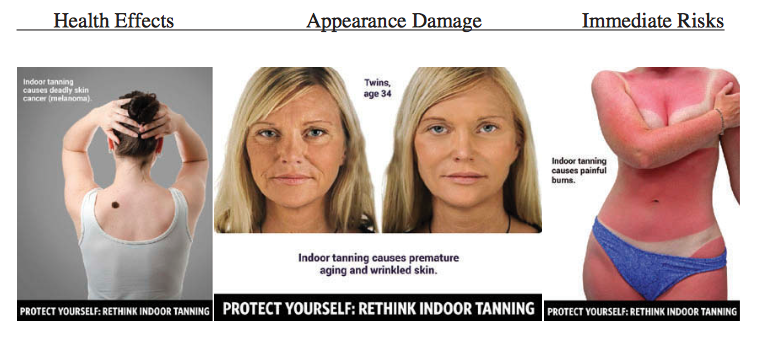Public-health campaigns focusing on reducing smoking have found that including graphically disturbing images in their messaging has proven to be effective. That same approach is now leading researchers to consider employing similar strategies when raising awareness of the damaging results – and potentially deadly dangers – of indoor tanning.
While studies have shown indisputably that tanning beds pose serious health threats, there's still a sizable segment of the population that simply ignores its health consequences – just like smokers, in their own way – because any deleterious effects are delayed and won't become apparent for years. What's more, the risk of skin cancer jumps by almost 60 percent for those who use tanning beds prior to age 35.
That's where graphic imaging comes in.
In a recent study targeting young women – the demographic which is most likely to use tanning beds – this approach to use images "produced greater negative emotional reactions and higher ratings of effectiveness in a survey of female college students."
That's the conclusion of a paper published in the Journal of Health Communications, titled "Assessing the Potential Effectiveness of Pictorial Messages to Deter Young Women from Indoor Tanning: An Experimental Study," conducted by researchers at the Lineberger Comprehensive Cancer Center at the University of North Carolina at Chapel Hill. The study, which was done in April 2015, involved 568 participants aged 18 to 22 (with the mean being 19.8 yrs) who were enrolled in a southern university.
However, while citing the study's success, it also came with a word of caution: That in order for the pictorial approach to be effective the chosen images need to be "realistic and believable," or they would be dismissed.
While a separate 2010 survey found that nearly a third of young American women aged 18-to-25 take part in indoor tanning, there has been little research on the effects of advertising to deter participation in this dangerous activity – which spurred these researchers to act.
"This study gives us some guidance as to what makes more effective messages targeting young women who use tanning beds or are thinking about using tanning beds," says Seth Noar, Ph.D, researcher and professor in the UNC School of Media and Journalism, in a statement released by the university.
Using images, like the ones below which appeared in the published paper, researchers found that health warnings resonated better with the participants as compared to ones containing only text.
“Because many women tan indoors to ‘improve’ their appearance, they should understand that their appearance is actually at-risk in the long-term,” said Jennah Sontag, the paper's first author, adding that "communicating these risks using visuals is much more hard-hitting."

Of the three physical effects shown to the participants – melanoma, the most dangerous skin cancer; eye wrinkles; and severe burning – one health consequence stood out.
In their paper, researchers noted that "the eye damage message was the most impactful health effects message, followed by melanoma. Thus, focusing on particular health effects of indoor tanning — such as permanent eye damage and melanoma — might produce desirable results, especially if the messages can be executed in a powerful way."
Of the 568 participants – 87 percent of which were white, 8 percent Hispanic and 2 percent Asian – 210 were categorized as "ever tanners" while 358 were classified as "non-tanners."
The Centers for Disease Control and Prevention reports that between 1995 and 2015 American adults who smoke dropped from 25 percent to 15 percent. Meanwhile, the rate for high-school students during that 20-year period plunged from 35 percent to 11 percent. Given this success, bolstered in part by awareness campaigns showing increasingly stark, disturbing imagery of sick and dying smokers, the idea to display the physical effects of indoor tanning in the same manner makes good sense.
"Visual messages that elicit strong negative emotional reactions are likely to produce positive outcomes," the authors wrote. "A series of studies assessing anti-smoking advertisements found that messages rated high in negative emotion were perceived as more effective and were more likely to be recalled than other types of anti-smoking messages."
Pictures, both still images and video, helped drive the point home about the dangers of smoking. This research appears to support a similar deterrent when it comes to indoor tanning. It's a smart approach to actually show that so-called beauty "benefits" in the short term will often lead to devastating – and possibly life-ending – physical damage years later.




